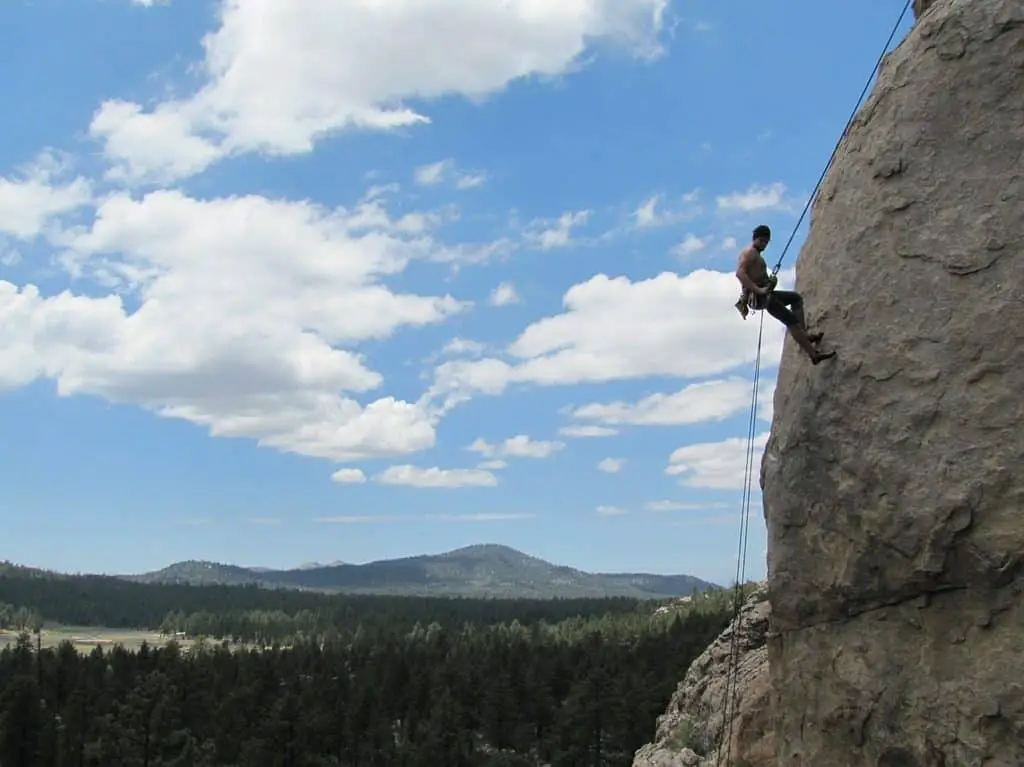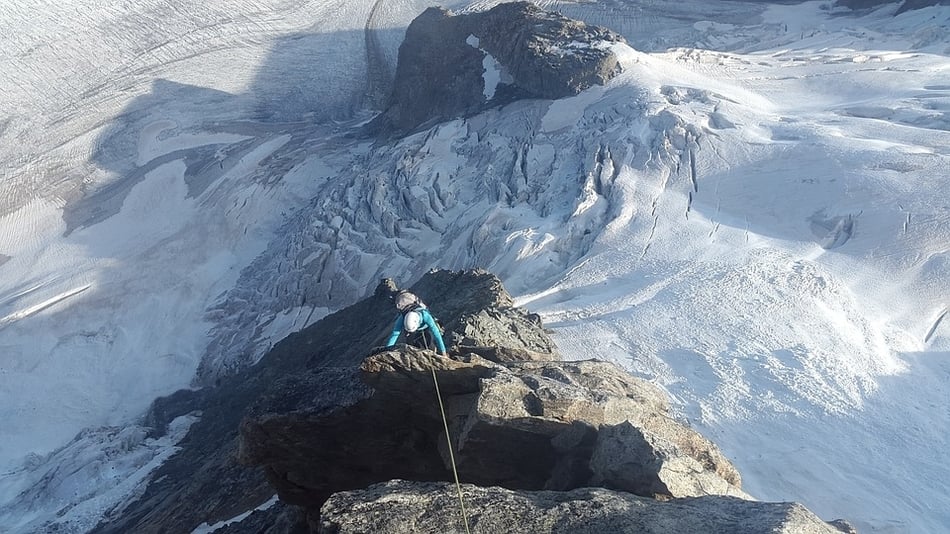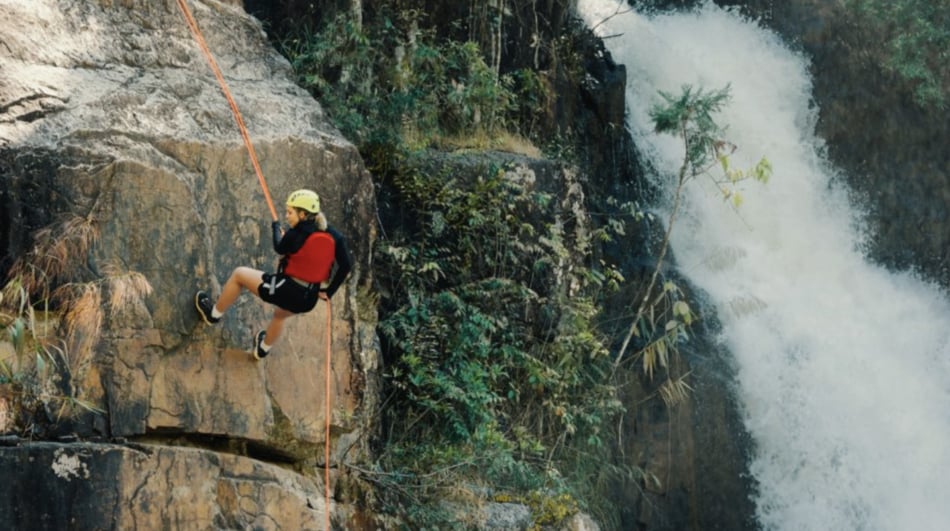
Rappelling is an amazingly fun way to get outside for the day. It’s also a highly dangerous activity, however, and a major part of rappelling safety is bringing the right gear along.
So, can you rappel with a dynamic rope? Yes. Dynamic ropes work perfectly well for rappelling, and in certain situations they may actually be favourable to a static rope. Dynamic ropes are built to flex and stretch when put under stress; this makes them ideal if you’re going to be using them for any kind of activity involving lots of movement.
Ice climbing, rock climbing, and alpinism are common activities that would require a dynamic rope. In these situations, it’s perfectly acceptable— and completely safe— to rappel with a dynamic rope. However, there are certain situations in which a static rope may be preferable. Factors such as the presence of water, the wear on the gear, and what activity you’re doing should be considered when deciding between a static and dynamic rope.
Static vs Dynamic Ropes
The distinction between static and dynamic ropes is one of the most important to learn before you engage in any rappelling or climbing-related activity. Though they may look the same to the naked eye, bringing the proper rope along with you can be the deciding factor between life and death in the mountains.

The difference between a dynamic and a static rope lies in the material that makes up the inner core of the rope. All climbing ropes have two components: the sheath and the core. The sheath is the braided outer layer that protects the core from wear and tear. It’s made up of tightly woven nylon fibres and is often brightly coloured. The core, on the other hand, is what gives the rope its tensile strength; it’s made up of interwoven polymer fibres that gives a rope the ability to bear weight.
In dynamic ropes, these polymer fibres are woven together in such a way that they stretch when they become load bearing. This allows the rope to lengthen under tension, softening the impact when force is applied. In climbing terms, this means that when you fall, the rope can stretch out in an elastic fashion, bringing you to a stop in a more gradual fashion. It’s what allows climbers to take fifty-foot falls and remain okay.
Static ropes have none of this stretching ability. Because the fibres don’t have the ability to stretch, when load is placed on a static rope, it simply goes taunt. Think about what this means in terms of climbing. If you take a big fall on a rope that doesn’t stretch, one of two things are going to happen: either you could put too much force on the rope, causing it to break, or you will come to an extremely abrupt stop. This sort of sudden impact can cause severe whiplash and other nasty spinal injuries.
Knowing whether your rope is static or dynamic is absolutely essential before you head out to go climbing. Static ropes are good for hauling gear and jumaring up routes, but they should never be used to protect a fall.
When To Use A Dynamic Rope
Now that we know the difference between a static and dynamic rope, let’s come back to thee original question. As you can see, there are certain situations in which you may have to use a dynamic rope. Say you’re going on a climbing expedition and you only have enough space to bring one rope with you. There’s no way to hike off the top of your climbing route, so you’re going have to rappel down. In this instance, it’s not just acceptable to bring a dynamic rope with you, it’s actually required. You’ll need the dynamic rope to climb with, and it will be all you have on the rappel down.

That being said, even when it’s not essential, there’s nothing wrong with using a dynamic rope to go rappelling, even if you don’t expect to take a fall on it. Dynamic ropes function perfectly well for rappels. There are, however, some things you want to take in to consideration before using your dynamic rope to rappel:
Cost
The attention and craftsmanship that goes in to making a dynamic rope far exceeds that of a static line. Because of that, dynamic ropes are more expensive than their static counterparts. Static ropes can be bought for about $2.50 per meter, whereas dynamic ropes are always going to be in the $3.50 and up range. Considering you will need tens of meters of rope, and that ropes are a piece of equipment that often need to be replaced, this price difference can start to add up.
While dynamic ropes are handy to have, they’re not always necessary. If all you plan to do is rappel or go caving, you may as well save yourself some money and just buy a static rope.
Wear and Tear
When rappelling, you’re going to be using a device that creates friction against the rope to slow you down and give you control. Some devices, like the Figure 8, do this by twisting the rope in opposing directions several times. Others, like a Black Diamond ATC or a Petzl Ascender, use small metallic ‘teeth’ that bite in to the rope to slow it down.
These teeth are perfectly safe to use, and can actually make the rappel easier to control. They do, however, increase the rate of wear and tear on your rope. As I stated above, this becomes more of an issue when you’re buying costly dynamic ropes. If you’re going out for the day and you’re certain that no climbing will be involved, it’s probably best to just stick with the static rope.
Presence of Water

When dynamic ropes become wet, they lose their strength under tensions and become unsafe to climb on. However, contrary to what some people may have told you, dynamic ropes can be used for rappelling even if they’re wet. As long as there’s no sudden impact being placed on the rope, it’s perfectly safe to use no matter how much water it’s absorbed.
That doesn’t, however, mean that you should go around trying to dunk your dynamic rope in water. Getting the rope wet can cause rotting at the core, which is detrimental to the lifespan of the rope. Bringing it back to the cost factor listed above, it may be best to leave the dynamic rope at home if you think you’re going somewhere wet.
Rappelling With Both
This is a question I see a lot of around the internet: can you combine a static and dynamic rope for a rappel? The answer is yes, but you need to be sure you know what you’re doing. Different stretch rates in the two ropes can cause inequalities in rappel length and endanger your rappel. If you’re going to use both a static and dynamic rope to rappel, make sure you follow the proper steps to avoid an accident. This article is a great resource for rappelling with one of each kind of rope.
So there you have it! Rappelling with a dynamic rope is not only possible, but is in fact highly encouraged in some situations. Dynamic ropes are safe, strong, and perfectly acceptable to rappel on, even though they may not be completely necessary in every situation.
Related Questions
How can you tell if a rope is static or dynamic? Manufacturers will attach a tag to the rope to tell you if it’s static or dynamic. If the tag has gone missing, it’s best to just assume the rope is static. Please don’t try to test the rope to see if it will flex; it takes quite a bit of force to stretch a dynamic rope, and the line between experimentation and injury can get quite blurry.
What Rope Should I Use For Rappelling? The proper rappelling rope depends on the situation you’re going to find yourself in. In this article, I go in to greater detail about what rope is best suited for what situation.
